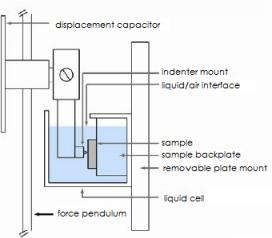 Mechanical properties of materials often vary considerably when in their normal fluid environment compared to the usual laboratory dry testing conditions. Probing the mechanical properties of biological samples in fluid media should prove a closer mimic of in vivo conditions than conventional dry nanoindentation testing.
Mechanical properties of materials often vary considerably when in their normal fluid environment compared to the usual laboratory dry testing conditions. Probing the mechanical properties of biological samples in fluid media should prove a closer mimic of in vivo conditions than conventional dry nanoindentation testing.
How it works
The testing capability of the NanoTest has been extended by the development of a liquid cell allowing nanoindentation, nano-scratch & wear testing of samples fully immersed in liquid. A friction transducer extension also allows immersed sample friction measurements. The fluid cell works with the existing pendulum design and the horizontal loading has several key advantages for testing in fluid.
- Constant buoyancy force
- Constant surface tension on loading column
- Liquid is not underneath capacitor
Liquid cell applications and investigating of soft materials immersed in liquids includes:

- Tribology
- Corrosion
- Tissue mechanics as a function of source, disease state, and exposure to soluble toxins or drugs
- Tissue properties as a function of submicron position within the tissue
- Porous materials (bone, cement, chemomechanics)
- Biocompatibility and biomaterials
- Dental enamel
- Micro particle friction and wear
- Polishing mechanics
Investigate a wide range of stiffness values

Research by MIT has shown that nanoindentation with the NanoTest liquid cell could be performed with sample fully immersed in liquid for materials spanning several orders of magnitude of stiffness from highly compliant gels to biological tissues.
